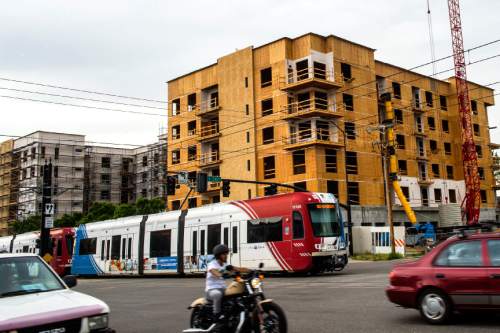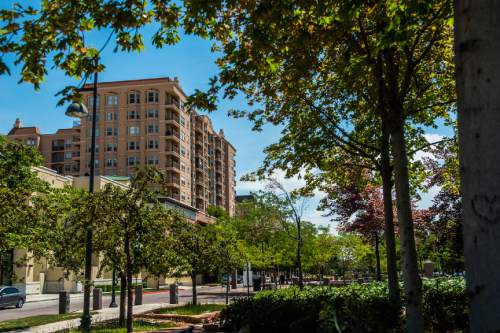This is an archived article that was published on sltrib.com in 2015, and information in the article may be outdated. It is provided only for personal research purposes and may not be reprinted.
Downtown Salt Lake City is seeing a residential building boom, but that is just one sign the urban core is healthy and growing.
Demand for office space, an uptick in retail sales, new energy on Main Street and expanding transit usage across downtown also underscore that the city's central business district is doing well, its supporters said Thursday.
At least a dozen new projects — offices, retail centers, new public facilities — are under construction, according to a yearly report released by Salt Lake City's Downtown Alliance.
"It's pretty exciting to think about what the skyline is going to look like," executive director Jason Mathis said.
But the Alliance's glowing outlook also cites an urgency in addressing persistent problems with the homeless, particularly on downtown's west side.
The group representing downtown merchants is also calling for changes in city ordinances on building impact fees and demolition in order to ease future downtown development.
And the Alliance, an arm of the Salt Lake Chamber, also wants the state Legislature to loosen longstanding restrictions on liquor licenses, to make way for new restaurants and bars considered vital to strengthening Salt Lake City's nightlife experience.
Eateries and taverns helped drive sales in downtown Salt Lake City to record levels for a second consecutive year in 2014, with receipts reaching $800.9 million as customers from across the region flocked to downtown stores, bistros, watering holes and social hubs.
Food and drink providers accounted for $330.4 million — 41 percent — of total downtown sales, the Alliance reported. The next highest sector — downtown sellers of clothing and accessories — accounted for $165.3 million in total sales for 2014, its report said.
A crucial component in that growth comes from City Creek Center, the Mormon church-built open-air shopping center spanning two city blocks along Main Street. Opened in 2012, the upscale center of stores, offices and apartments continues to enjoy rising visitorship from shoppers in the Salt Lake Valley, adjacent counties and nearby states, a top mall executive said.
Surveys indicate that "overwhelmingly, downtown is the leading shopping destination for Utah," said Linda Wardell, general manager for City Creek Center.
Trends in office space also point to a similar recovery in economic vitality for the city's core.
Vacancies in downtown offices inched down last year and asking prices on leases climbed higher, indicators that demand is up as new businesses continue to locate or expand in Utah's capital. Developers have another 439,611 square feet of new downtown office space under construction.
"Downtown Salt Lake City is obviously a very vibrant place right now," said Scott Wilmarth, senior vice president at the commercial real-estate firm CBRE.
Nearly 1,800 new residential apartments were either completed or under construction in central Salt Lake City as of June, the report said. This reflects Utah's job growth and demand from a new generation of adults for an urban lifestyle focused on renting.
"This younger generation, particularly millenials, is looking for the convenience of living close to where they work," Wilmarth said, "but also enjoying some of the cultural amenities associated with downtown."
Along with new office towers, hotels and shopping areas now going up downtown, the report notes 14 separate apartment complexes either recently completed, under construction or planned for the 501-acre central business district.
And while the surge in residential building is welcomed by downtown boosters, it is also raising key concerns.
The Alliance says there is "a significant gap" in housing options for moderate-income and working class families who might want to live downtown but can't afford it. Most of the new construction, the report notes, caters to wealthier renters with high-end amenities and features.
Meanwhile, the window for addressing that problem may be closing.
A major Utah developer of multifamily residential projects said concern is growing that large numbers of new apartments will create an oversupply, potentially driving down rents and investor returns, leading to a construction slowdown.
Corey Johnson, vice president with Wasatch Properties, predicted the current spike in apartment building will slow within two years.
"We're nervous about supply right now," Johnson said. "We're wondering just how deep the market is."
Twitter: @TonySemerad





